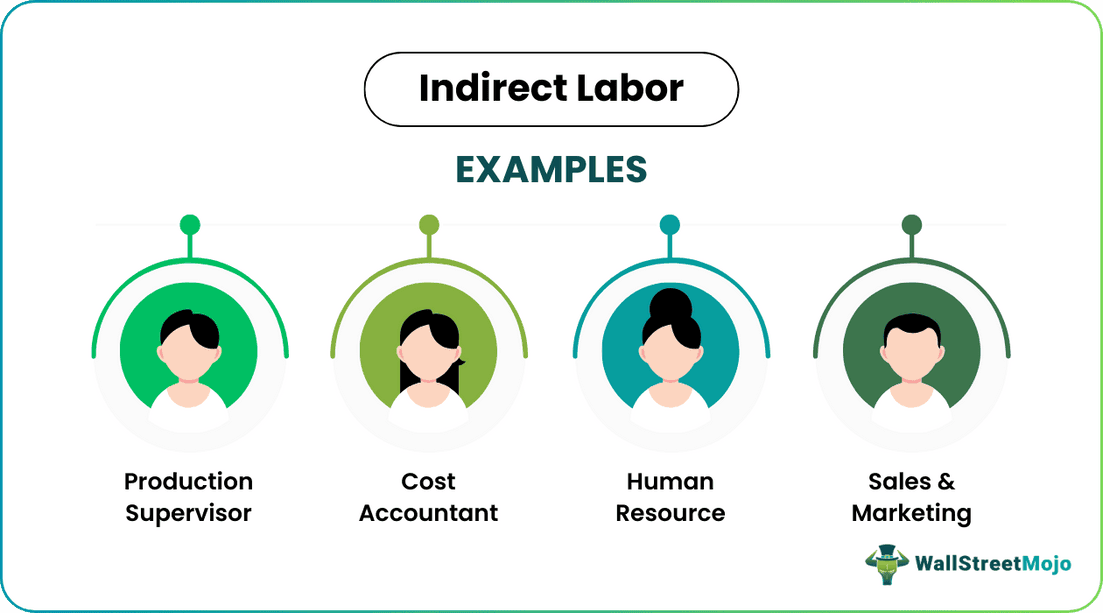Table Of Contents
Key Takeaways
- Indirect labor refers to employees not directly involved in the finished goods or services production procedure. Nevertheless, they must back the production and manufacturing ecosystem along with accountants, human resources, sales, marketing teams, etc.
- Indirect labor cost is included in the overhead cost that consists of indirect material and indirect expenses.
- The indirect labor examples are the production supervisor, human resource, cost accountant, sales, and marketing.
- Direct labor can be analyzed with a specific cost center, while indirect labor (IL) cannot be identified with a particular cost center.
What Is Indirect Labor?
Indirect labor refers to employees who are not directly involved in the production process of finished goods or services. However, they must support the production and manufacturing ecosystem, including accountants, human resources, sales, marketing teams, etc.

Thus, indirect labor cost is a part of the overhead cost, comprising indirect material and indirect expenses. Include area accounting, engineering, human resource, or administrative work. People working in these fields do not contribute hands-on to converting raw materials into finished goods. Such labor costs are the overhead costs of direct and indirect materials.
Key takeaways
Indirect Labor Explained
Indirect labor helps in producing goods and services but are not directly or actively involved in converting raw materials into finished goods. They mainly include material handling, purchase and management staffs, supervisors or people who are responsible for quality maintenance, accounting, administrative work or even human resource management.
It plays a vital role in overall business operation as it is involved in every stage of business like the purchase of raw material, handling of raw material and finished goods, direct labor and their supervision, arranging all the infrastructure required for production, assigning all the cost to their cost center, marketing and advertisement of the product, and selling of finished goods. However, they are not directly associated with converting raw materials into finished goods; the costs are known as indirect labor overhead.
Types
Let us look at the types of indirect labour in cost accounting.
- Production Supervisor: The production supervisor is only responsible for supervising the production process and monitoring the laborers directly involved in the production, but they do not play a role in converting raw material into finished goods.
- Cost Accountant: The Cost accountant role is responsible for assigning the cost related to the production.
- Human Resource: The HR department is responsible for recruiting all the employees in the organization, whether directly or indirectly related to the production.
- Sales & Marketing: These are responsible for marketing and selling the finished products into the market.
How To Calculate?
Let us learn how to calculate indirect labour in cost accounting with the help of the below examples.
- XYZ Inc manufactures three types of products – A, B, and C. Direct material and direct labor associated with these products differ. However, they can be easily identified, and their cost can be separately charged to the production cost. However, indirect labor and material can not be identifiable and charged directly to the cost of production. Therefore, indirect costs are apportioned amongst these three products based on the number of units produced.
Example
Let us go through the example of indirect labour to understand the concept.
In the below example, direct material and direct labor costs are charged per unit of product A. Its direct material cost is $5, and its direct labor cost is $3. For product B, the direct material cost is $6, and the direct labor cost is $4. And for product C, the direct material cost is $10, and the direct labor cost is $5.
These costs depend on the number of units produced. At the same time, indirect material and indirect labor overhead are not derived on a per-unit basis. Instead, it can be charged by dividing the total indirect labor cost by the total number of units produced and then apportioning it amongst these three products according to the number of units produced.
Total indirect labor cost = $150,000
Total no. of units produced = 7,500 (2,000 + 2,500 + 3,000)
Indirect Labor Cost for Product A = Total Indirect Labor cost / Total No. of Units Produced * No. of Units for Product A
- = 15,000 / 7,500 * 2,000 = 40,000
Similarly, it will be $50,000 and $60,000 for products B and C, respectively.

The above mentioned example of indirect labour gives a clear idea about the concept.
Direct Labor Vs Indirect Labor(IL)
Some basic differences between direct and indirect labour is given below:
- Direct labor can be identified with a particular cost center, while indirect labor (IL) can not be recognized with a specific cost center.
- Direct labor is directly concerned with the productions, but IL is not directly related to the productions.
- Direct labor cost is determined based on the number of hours worked or units produced, but IL cost is not calculated in this manner.
- The direct labor workforce can easily be reduced if demand decreases, but IL cannot be reduced.
- Direct labor costs are part of the direct cost of production. In contrast, indirect labor costs form part of the overhead cost, whether it is production, selling, distribution, or any other overhead.
Thus, the above are the differences between direct and indirect labour.

